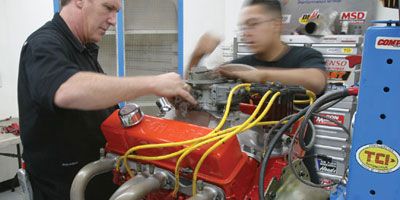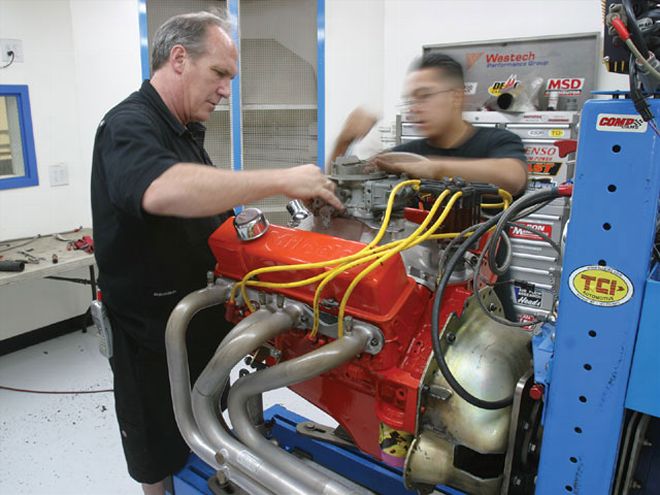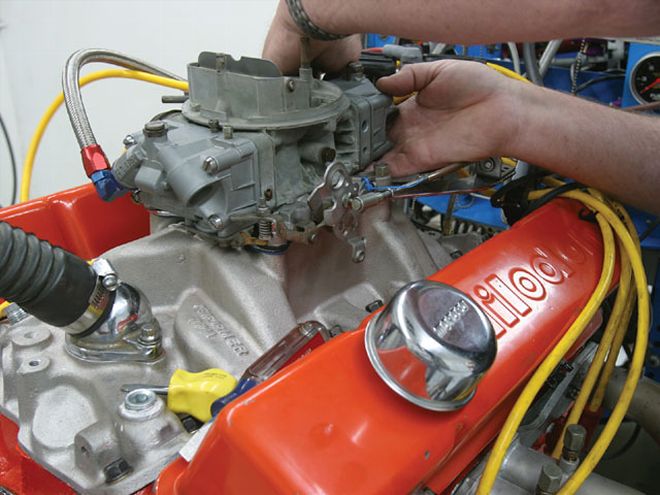
 The engine wound up on Westech's engine dyno, but it didn't start out in such pristine condition. A rusty old short-block lying in the dirt at a local junkyard is where this orphan found new life after Tim Moore rescued it from the smelter.
The engine wound up on Westech's engine dyno, but it didn't start out in such pristine condition. A rusty old short-block lying in the dirt at a local junkyard is where this orphan found new life after Tim Moore rescued it from the smelter.
There was a saying during the dark days of the '30s Great Depression that proclaimed "Use it up, wear it out, make it do, or do without." Perhaps the 21st-century car craft version of this is "I want to make horsepower, but I don't wanna spend a lot of money to get there." To celebrate the budget horsepower builder in all of us, we embarked on an adventure in bargain-hunting and parts-chasing for a 385ci small-block Chevy that is not only powerful, but also especially fiscally friendly. The bottom line is that this motor cost less than a set of high-end aluminum small-block Chevy cylinder heads yet makes 383 hp and 436 lb-ft of torque. That's more than enough to convert the most taciturn Chevelle or Camaro into a machine that runs like a scalded dog.
Ironclad
Tim Moore has become famous around this magazine for finding or creating good deals on performance parts. He'll also admit that it's often better to be lucky than good. For several months he had been searching for the right price on a one-piece rear main seal short-block that he could build into a budget small-block Chevy. When he heard that a local Sun Valley, California, junkyard was liquidating its stock and closing its doors, he decided to investigate the opportunities. There he ran across a small-block Chevy one-piece rear main seal short-block sitting in the dirt amid assorted automotive detritus. The motor had been sitting outside so the cylinders were a bit rusty, but what caught Moore's attention was the offset weight balancer. It signaled to him that this could be a cast crank 385 short-block. Following a quick negotiation, he paid $75 and dragged the short-block back to his shop.
After Moore yanked the pan, a dousing with WD-40 and several mallet strikes were required to convince all eight pistons to move so he could check the stroke. This quickly revealed a 3.75-inch stroke, confirming the engine as a 385. After removing all the pistons, Moore tried several different methods including carburetor cleaner, buffing, and small picks to try to loosen the rings' grip on two corroded pistons. When the only way to remove the rings was to break the pistons, Moore decided that a new set of slugs was affordable since at this point he had a very small initial investment.
This decision set the tone for the rest of the short-block, because he soon discovered that the Scat crank had suffered some abuse that required machining and that there was sufficient rust to necessitate some cylinder boring. Moore took the block to Don Barrington Engines in Van Nuys, California, where this father-and-son team took on the machine work. The first step was to get the block clean (Moore elected to leave the brass freeze plugs in place) and to Magnaflux to remove any concern about cracks. With a solid foundation, the first decision involved pistons. While cast pistons are the cheapest, Moore opted for a set of Keith Black hypereutectic dished pistons to make the compression compatible with California's 91-octane fuel. The rod bearings looked halfway decent, so Moore decided to just clean the rods and not resize them. The oil pump, pickup, and oil pan were all in great shape, so he sanitized them and bolted 'em back in place after welding the pickup into the oil pump and adding the factory Z28 white spring that pumps the pressure up to around 65 psi.
At almost this same time, Moore ran across two more opportunities on the swap-meet tour that sealed this deal. The first was a used Comp Cams Xtreme Energy hydraulic roller cam, and the other was a set of older 76cc-chamber, 882-casting-number iron heads that had already seen the light with bigger springs, screw-in studs and guideplates, and big valves. The iron heads also gave his motor its nickname of Ironclad.
Hydraulic Roller Secrets
The main reason Moore went looking for a one-piece rear main seal small-block Chevy in the first place was because he knew that a hydraulic roller lifter cam would generate a bit more power than the more traditional flat-tappet hydraulic version. By using a one-piece rear main seal engine set up for factory hydraulic roller lifters, he also knew he could find used lifters for next to nothing. We outlined the details of this idea in the Oct. '07 issue in "Secrets of the Cheap Hydraulic Roller Cams." The essential element in this story is that used hydraulic roller lifters can be safely run on either new or used hydraulic roller camshafts. Combine this concept with the fact that used factory small-block hydraulic roller lifters are extremely plentiful in junkyards and you have several of the main ingredients for a budget small-block performance engine. It doesn't get much easier.
A Question Of Balance
One of the confusing things about the one-piece rear main seal small-block Chevys is internal versus external balance. All production two-piece rear main seal, internally balanced small-block Chevys employ a small offset weight on the flywheel end of the crankshaft. When GM converted to the one-piece rear main seal (still internally balanced), it was not possible to add that small eccentric weight on the aft end of the crank. So it was added to the flywheel or flexplate. However, the harmonic balancer still remained an internally balanced component, meaning that it has no external eccentric weight.
Now add an externally balanced stroker 385 crank to a one-piece rear main seal block, and it gets a little more complicated. Some stroker crank assemblies are offered as internally balanced, but they still require the standard one-piece rear main seal eccentric weight. In Moore's case, this engine was equipped with an externally balanced Scat one-piece rear main seal crank. This means this engine required a standard 400-style harmonic balancer in the front while retaining the standard one-piece rear main seal flywheel/flexplate. Scat actually recommends adding a 1-inch-diameter slug of Mallory metal in the first counterweight and "internally" balancing this stroker crank, which would allow the use of a standard noncounterweighted harmonic balancer. Either path is acceptable, so Moore stuck with his original balancer but did have the whole rotating assembly balanced with the new pistons.
Testing Ironclad
After Moore had carefully assembled the 385, we trundled it out to Westech Performance Group for a chance to abuse it on the SuperFlow dyno. Compared to a few of the massive parts comparison tests we've subjected Steve Brul to recently, this test was really more of a fun day since all we wanted to do was see how much power we could squeeze out of old Ironclad.
With the used dual-plane and the relic Holley carburetor sitting on top of an obvious pair of plain-Jane iron heads, the engine struck a not-too-imposing figure on Westech's dyno, which has been witness to 2,000hp, turbocharged, 540ci Rat boat motors. Another minor advantage of a hydraulic roller cam is that we didn't have to sweat breaking in the cam or bother with extra zinc-enhanced additives. We just dumped in 5 quarts of Pennzoil and ran the engine through a complete warmup until we had sufficient heat in the oil to ensure everything was up to temperature.
The first few pulls established that the engine liked 36 degrees of ignition timing, and we messed around with jetting the Holley carb and ascertaining that the vacuum-secondary throttle blades were fully opened under power. Moore had placed the jetting slightly richer than stock, and we went a couple of sizes leaner in search of more power, but stopped when it became apparent that leaning the jetting at the lower end of the rpm scale only hurt the peak power. This demanded an overall jetting compromise that is also typical of street-type carburetors. We felt it was beyond the scope of this engine's budget nature to dive too deeply into the carburetor.
Our best pull out of over 20 runs on the engine netted an impressive peak torque of 439 lb-ft at a very streetable 3,900 rpm, while best power occurred at a conservative 5,300 rpm with a 383hp number. While we were hoping for slightly more power, the payoff is both a strong small-block that's easily capable of low-13- to high-12-second dragstrip passes but also excellent boulevard manners as a result of the conservative hydraulic roller cam. This motor could easily make more power with a better set of heads, but on the cash-strapped street-hero scale, this is an Ironclad winner.
CAM SPECS Description Duration Duration Lift Lobe Separation (Adv.) (@ 0.050) Comp X270HR, int. 270 218 0.495 110 08-422-8, exh. 276 224 0.535Stock lift at 1.5:1 rocker ratio is 0.502 inch. This cam is listed with higher lift because of the 1.6:1 rocker ratio used on the exhaust side only.
PARTS LIST DESCRIPTION PN SOURCE PRICE Short-block, crank, and rods used junkyard $75.00 Stock iron heads, 882 castings used swap meet 150.00 Comp hyd. roller cam used swap meet 75.00 Edelbrock Performer RPM intake used swap meet 50.00 Holley 3310 750-cfm vac. sec. used swap meet 20.00 Hays Stinger distributor and box used swap meet 15.00 Valve covers, w/ breathers used swap meet 10.00 Accel spark plug wires used swap meet 25.00 Hydraulic roller lifters, retainers used junkyard 10.00 Crane 1.5 nitro-carb rockers 11801C came w/ heads N/C Crane 1.6 nitro-carb rockers 11802C came w/ heads N/C KB hyper pistons, dished KB-197040-8 Competition Prod. 255.69 Perfect Circle rings, 5¼64 PFT50564CP040 Dougherbert 26.99 Clevite 77 main bearings, -0.010 MS909P-10 Competition Prod. 21.99 Clevite 77 rod bearings, -0.010 CB663R-10 Rock Auto 16.32 Clevite 77 cam bearings SH290S Competition Prod. 15.99 Bosch spark plugs, HR9BC Super 7575 Rock Auto 12.96 {{{Summit}}} Racing timing chain set 66601 Summit Racing 37.95 Victor gasket set, one-piece rear seal 95-33417VR CNC Motorsports 89.95 Holley Renew rebuild kit, 4150 37-935 Summit Racing 27.95 Comp 5¼16 heat-treated pushrods 7808-16 Summit Racing 35.88 Cam freeze plug ---- local auto parts 2.99 GM Z28 oil-pump spring 3848911 Scoggin-Dickey 3.37 Pennzoil 10w30 10w30 local auto parts 11.50 Oil filter, Fram PH5 local auto parts 5.50 Machine work, Barrington Engines Clean 54.00 Magnaflux 50.00 Bore and torque-plate hone 288.00 Deck block 188.00 Crank turned 125.00 Balanced 125.00 Pocket porting, 882 iron heads 125.00 Grand total: $1,950.03 It doesn't get much more modest than a set of iron production heads, a used Edelbrock Performer RPM intake, and a 780-cfm Holley swap-meet refugee carb. But all these parts still managed to produce 383 hp and 439 lb-ft of torque.
Power Numbers RPM TQ HP A/F Ratio 2500 402 191 12.1 2700 400 205 12.0 2900 413 228 12.0 3100 424 250 12.2 3300 430 270 12.4 3500 434 289 12.6 3700 438 308 12.8 3900 439 326 12.7 4100 436 340 12.8 4300 431 353 12.7 4500 424 363 12.6 4700 415 371 12.6 4900 404 377 12.4 5100 392 381 12.5 5300 379 383 12.4 5500 365 382 12.6 5700 350 379 12.8 Peak 439 383 12.8 Avg. 411.4 318 12.5
It doesn't get much more modest than a set of iron production heads, a used Edelbrock Performer RPM intake, and a 780-cfm Holley swap-meet refugee carb. But all these parts still managed to produce 383 hp and 439 lb-ft of torque.
Power Numbers RPM TQ HP A/F Ratio 2500 402 191 12.1 2700 400 205 12.0 2900 413 228 12.0 3100 424 250 12.2 3300 430 270 12.4 3500 434 289 12.6 3700 438 308 12.8 3900 439 326 12.7 4100 436 340 12.8 4300 431 353 12.7 4500 424 363 12.6 4700 415 371 12.6 4900 404 377 12.4 5100 392 381 12.5 5300 379 383 12.4 5500 365 382 12.6 5700 350 379 12.8 Peak 439 383 12.8 Avg. 411.4 318 12.5